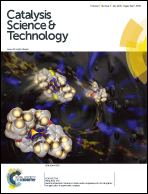A new perspective on catalytic dehydrogenation of ethylbenzene: the influence of side-reactions on catalytic performance
Abstract
The dehydrogenation of ethylbenzene to styrene is a highly important industrial reaction and the focus of significant research in order to optimise the selectivity to styrene and minimise catalyst deactivation. The reaction itself is a complex network of parallel and consecutive processes including cracking, steam-reforming and reverse water-gas shift (RWGS) in addition to dehydrogenation. The goal of this investigation is to decouple the major processes occurring and analyse how side-reactions affect both the equilibrium of ethylbenzene dehydrogenation and the surface chemistry of the catalyst. Studies have employed a CrOx/Al2O3 catalyst and reactions have been conducted at 500, 600 and 700 °C. The catalyst and reaction have been investigated using elemental analysis, temperature programmed oxidation (TPO), temperature-programmed desorption (TPD), Raman spectroscopy, THz time-domain spectroscopy (THz-TDS), X-ray photoelectron spectroscopy (XPS), in situ infrared spectroscopy and on-line gas chromatography and mass spectrometry. The reaction profile shows an induction time corresponding to a cracking regime, followed by a dehydrogenation regime. The cracking period involves the activation of CrOx/Al2O3 catalysts for dehydrogenation activity through a number of processes: cracking of ethylbenzene over acid sites; coke deposition; reduction of chromium from Cr(VI) to Cr(III); steam reforming activity over the reduced catalyst; and reverse water-gas shift reaction. Each of these processes plays a critical role in the observed catalytic activity. Notably, the presence of CO2 evolved from the reduction of chromium by ethylbenzene and from the gasification of the deposited oxygen-functionalised coke results in the dehydrogenation reaction becoming partially oxidative, i.e. selectivity to styrene is enhanced by coupling of ethylbenzene dehydrogenation with the reverse water-gas shift reaction. Ethylbenzene cracking, coke gasification, steam-reforming and reverse water-gas shift determine the relative quantities of CO2, CO, H2 and H2O and hence affect the coupling of the reactions. Coke deposition during the cracking period lowers the catalyst acidity and may contribute to chromium reduction, hence diminishing the competition between acid and metal sites and favouring dehydrogenation activity.



 Please wait while we load your content...
Please wait while we load your content...